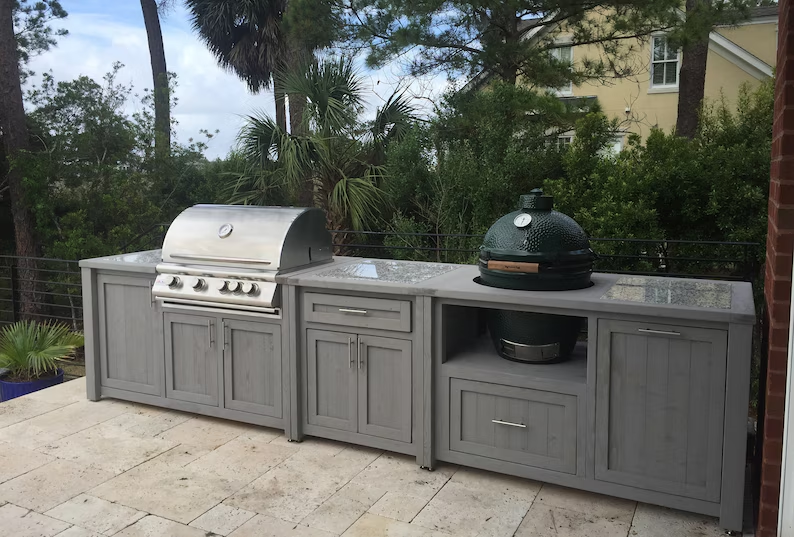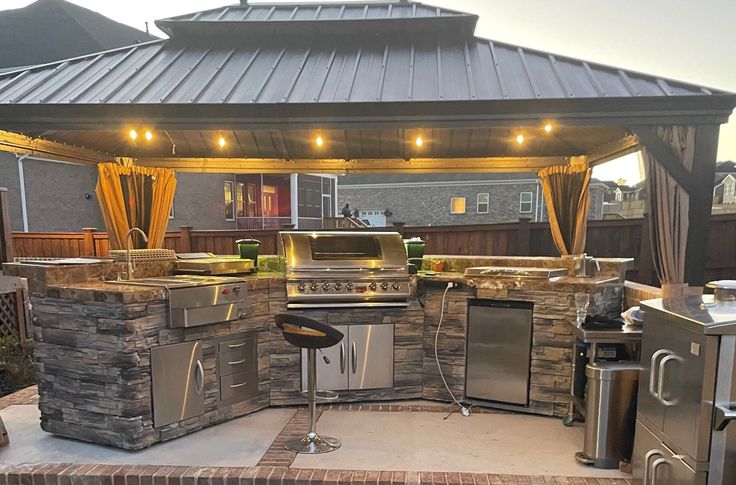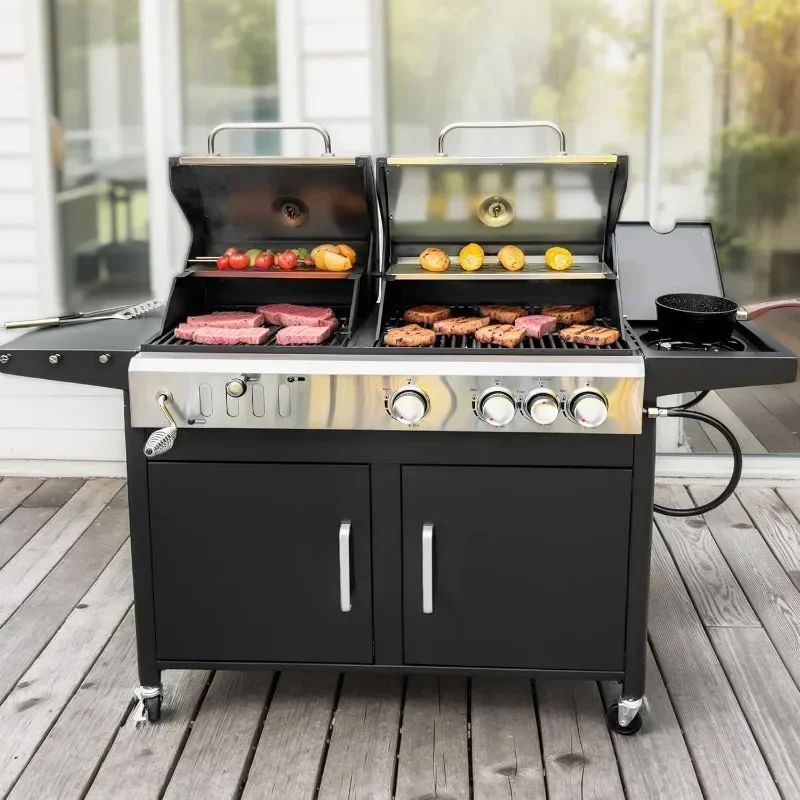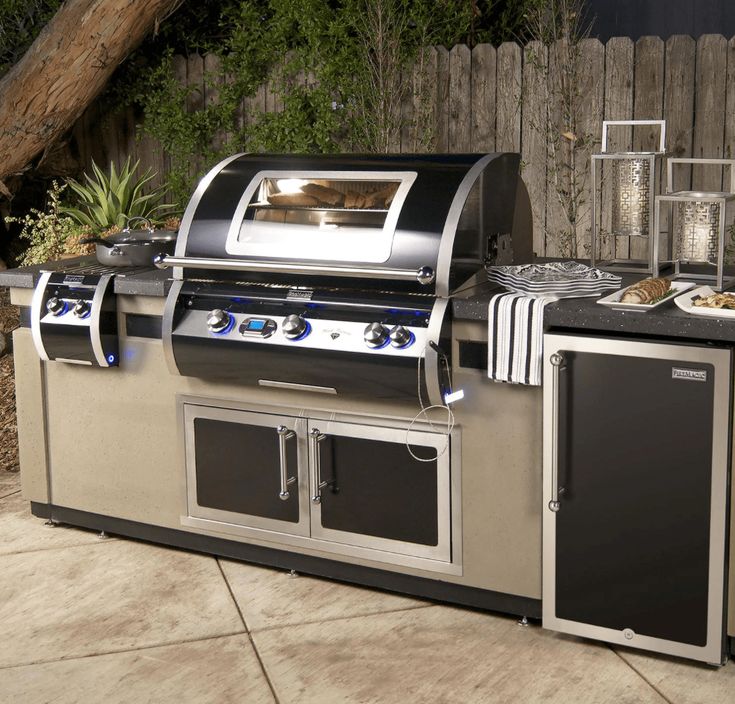
Backyard cooking is one of the simplest pleasures. Yet, for someone new, standing in front of a grill can feel confusing. Questions come up about heat, tools, and even safety. Many beginners worry about burning food, starting a fire, or simply not knowing what to do next.
A beginner can grill well by choosing the right type of grill, learning how to manage heat, using the right tools, and following simple safety steps. This guide breaks it down step by step so first-time grillers can cook confidently.
Grilling is not about being perfect on the first try. It is about practice and enjoying food outdoors. The sections below will answer the most common beginner questions and help you move from unsure to confident.
What grill type is best for beginners?

Many new grillers start by asking which type of grill is best. The choice often comes down to gas or charcoal. Both can make tasty food, but they work very differently.
Gas grills are easier for beginners because they light fast, hold steady heat, and are simple to control with knobs. Charcoal grills cost less and give smoky flavor but take longer to master.
When you think about a grill, you should also think about where you live and how often you want to cook. If you want quick weeknight dinners, gas may fit better. If you like the tradition of lighting coals, waiting for smoke, and cooking slowly, charcoal can be fun. Some people even own both.
Main grill options
| Grill Type | Pros | Cons |
|---|---|---|
| Gas | Fast, clean, steady heat | Higher cost, less smoky flavor |
| Charcoal | Rich smoke, cheaper | Takes time, harder to control |
| Electric | Indoor use possible | Less outdoor flavor |
| Ceramic “egg” | Holds heat long, versatile | Heavy, expensive |
The best grill is the one you will actually use. If you are afraid of the setup each time, you may stop grilling. Beginners often find gas easier, then later explore charcoal for flavor.
How do gas and charcoal grills compare?
The question of gas vs. charcoal has been asked for decades. People argue about taste, cost, and effort.
Gas grills win for speed and convenience, while charcoal grills win for smoky flavor and higher heat searing. Both can make great food, but the experience is different.
Gas grills are much like a kitchen stove. You turn a knob and within minutes, the grill is hot. Temperature is simple to adjust. This makes it less stressful for new cooks. Charcoal requires fire building. You light coals, wait 20–30 minutes until they turn gray, then spread them. It is slower, but many love the ritual.
Flavor difference
- Gas: clean heat, mild flavor
- Charcoal: smoke-infused taste, more depth
Cost difference
- Gas: higher upfront price, lower fuel cost long-term
- Charcoal: cheaper grill, but more fuel expense over time
So which is better? Neither. They serve different goals. Gas is for easy weekday meals. Charcoal is for weekends, parties, or when taste matters most.
What tools should every griller have?

Once you have your grill, you need the right tools. Regular kitchen utensils are not safe near high flames. Grilling tools are longer and stronger.
Every beginner needs long tongs, a sturdy spatula, a grill brush, and a thermometer. These basic tools keep food safe, prevent burns, and improve results.
Basic grill kit
| Tool | Purpose |
|---|---|
| Long tongs | Flip meat and veggies safely |
| Wide spatula | Handle burgers and fish |
| Grill brush | Clean hot grates |
| Instant thermometer | Check meat safely |
| Skewers | Hold small foods |
| Basting brush | Add sauces easily |
A grill station should always be ready. Place tools on a side table or hanging hooks. That way, you are not running inside the kitchen while food cooks.
How do you start a gas grill safely?
Many people feel nervous about gas. The thought of propane can seem unsafe. But with the right steps, it is simple.
To start a gas grill, open the lid, turn on one burner, press the ignition, and wait for the flame. Then set other burners as needed. Always keep the lid open during ignition to prevent gas buildup.
Safe steps
- Open the lid.
- Turn on gas supply (valve counterclockwise).
- Turn one burner knob to high.
- Press ignitor until it clicks and lights.
- Once lit, turn on other burners.
- Preheat for 10–15 minutes before cooking.
If the grill does not light in a few seconds, turn everything off, wait a minute for gas to clear, then try again.
How do you light a charcoal grill quickly?
Charcoal takes patience. Beginners often struggle because coals take time to heat.
The best way to light charcoal is with a chimney starter. Fill it with charcoal, place newspaper or cubes under it, light, and wait until coals turn gray before spreading.
Without a chimney, people often use lighter fluid. But fluid can affect flavor and must be used carefully. A chimney is safer and gives even results.
Tips for faster charcoal
- Use lump charcoal, it lights faster than briquettes.
- Keep vents open to feed oxygen.
- Do not dump coals until covered with white ash.
A little waiting pays off. Rushing often leads to uneven heat or burnt food outside and raw inside.
What is the difference between direct and indirect heat?
Grilling is not only about fire. It is about where you place food.
Direct heat cooks food fast right above flames. Indirect heat cooks slower away from flames. Beginners should use both methods to control cooking.
Direct heat is best for thin cuts like burgers, hot dogs, or steaks. Indirect heat is best for chicken, ribs, or larger roasts. Many grills allow a two-zone setup: coals on one side or burners on one side, food on the other.
Quick comparison
| Cooking Style | Example Foods | Time |
|---|---|---|
| Direct Heat | Burgers, veggies, shrimp | Fast |
| Indirect Heat | Chicken, ribs, roasts | Slow |
Learning when to move food between zones is one of the most useful beginner skills.
How do you control grill temperature easily?
Beginners often wonder how to stop food from burning or undercooking.
On gas grills, temperature is controlled with knobs. On charcoal grills, vents and coal placement control heat. More oxygen equals hotter fire, less oxygen cools it down.
On gas, turn knobs slightly to lower or raise flame. Use built-in thermometers for guidance. On charcoal, close vents partly for lower heat. Arrange coals for zones: more on one side for high heat, fewer for low.
A good trick is the hand test. Hold your hand above the grate (safely, not touching). If you must pull away in 2 seconds, it is high heat. 4–5 seconds means medium. 6–7 seconds means low.
Why is preheating a grill important?
Many skip preheating. They throw food on right away.
Preheating ensures food does not stick, kills bacteria, and gives strong sear marks. Always heat the grill for 10–15 minutes before cooking.
Cold grates cause meat to stick and tear. Preheated grates seal food quickly. It also helps even out temperature across the surface.
For charcoal, wait until coals are gray and glowing. For gas, close lid and let it heat. Preheating also burns off old food bits, making cleaning easier.
How do you clean grill grates effectively?
A dirty grill is a beginner’s biggest mistake. Old food sticks, causes flare-ups, and ruins taste.
The best way to clean grates is with a grill brush while they are still hot. Scrub after preheating and again after cooking.
Some use aluminum foil balls with tongs as a scrubber. Wire brushes work, but replace if bristles loosen. For deep cleaning, soak grates in hot soapy water, then scrub and rinse.
Cleaning routine
- Before cooking: brush hot grates clean.
- After cooking: brush again, wipe with oil.
- Monthly: deep clean inside and drip tray.
Good cleaning habits extend grill life and improve flavor.
How do you season a grill before use?
Seasoning is not only for cast iron pans. It also helps with grills.
Seasoning a grill means coating grates lightly with oil and heating them, creating a non-stick surface that prevents rust and sticking.
Use oil with high smoke point like canola. Apply with paper towel or brush. Heat grill on high for 20–30 minutes until oil burns in. Repeat a few times when new, then once a month.
Seasoning protects metal, adds flavor, and makes cleaning easier.
What safety steps should beginners follow?

Safety is the most important part of grilling. Many accidents happen when people leave grills unattended.
Keep grill outside, never indoors. Check gas connections, keep water and fire extinguisher nearby, and never leave grill running alone.
Key safety rules
- Place grill at least 10 feet from house.
- Check propane tanks for leaks.
- Keep children and pets away.
- Wear short sleeves or tie back clothing.
- Keep lid nearby to smother flare-ups.
Grilling is safe if you respect fire. Take a few seconds to check setup before lighting.
How do you prevent flare-ups while grilling?
Flare-ups happen when fat drips onto fire. They can burn food and cause danger.
To prevent flare-ups, trim excess fat, avoid pressing meat, and keep a cooler zone on the grill to move food quickly.
Do not spray water. It spreads flames. Instead, cover with lid to reduce oxygen. On gas grills, turn off burner under food. On charcoal, move food to side without coals.
Managing flare-ups is part of learning. With time, you can control them easily.
What foods are easiest for first-time grilling?
Beginners should start simple. Complex dishes can wait.
Chicken breasts, burgers, hot dogs, corn, and skewered veggies are the easiest foods for first grilling attempts.
They cook fast, do not require long preparation, and help you practice heat control. Once you master basics, try steaks, fish, or larger cuts like ribs.
Beginner-friendly foods
| Food | Why Good for Beginners |
|---|---|
| Burgers | Fast, forgiving |
| Hot dogs | Simple, safe |
| Corn | Easy side dish |
| Chicken | Common, versatile |
| Veggie skewers | Colorful, healthy |
Easy foods build confidence. Success early makes you want to keep grilling.
How do you check meat doneness correctly?
Many beginners cut meat open to check. This loses juices and dries food.
The best way to check doneness is with an instant-read thermometer. Insert into thickest part and compare with safe cooking temperatures.
Safe internal temperatures
| Meat | Temperature |
|---|---|
| Chicken | 165°F (74°C) |
| Ground beef | 160°F (71°C) |
| Steak medium | 135°F (57°C) |
| Fish | 145°F (63°C) |
Thermometers remove guesswork. They also keep food safe to eat.
Should you grill with the lid open or closed?
This depends on what you are cooking.
Thin foods like burgers or shrimp can be cooked with lid open. Thicker cuts like chicken or roasts cook better with lid closed to trap heat.
Open lid is like pan cooking, quick and seared. Closed lid turns grill into oven, cooking food through. The rule: under ¾ inch thick, lid open. Over ¾ inch thick, lid closed.
How do you stop food from sticking to grates?
Food sticking ruins presentation.
To stop sticking, preheat grill, oil grates, and avoid moving food too soon. Once seared, food releases on its own.
Brushing food with light oil also helps. Avoid sugary marinades early; they burn and glue food to grates. Pat meat dry before grilling.
What are common grilling mistakes to avoid?
Beginners often repeat the same errors.
The biggest mistakes are not preheating, flipping too often, pressing meat, skipping cleaning, and leaving grill unattended.
Each mistake reduces flavor or creates danger. Avoid them, and your grilling will improve fast.
How do you store a grill for long life?
Grills can last many years if stored well.
To store a grill, clean it fully, cover it with a weatherproof cover, and keep propane tanks outside in a safe place.
Never store propane indoors. Covers protect from rust and dirt. For charcoal, empty ashes. For gas, close valves and disconnect tanks if storing for winter.
Conclusion
Grilling is simple once you know the basics. The right grill, proper tools, safe lighting, heat control, and good cleaning make the process easy. Beginners should start small, practice with safe foods, and enjoy the process. Every meal teaches something. With time, confidence grows, and grilling becomes second nature.
Whether you choose gas for speed or charcoal for flavor, the joy is the same. Grilling connects people, fills backyards with smoke and laughter, and turns simple food into something memorable.
Would you like me to expand this article with a dedicated FAQ section (6–8 real Google PAA questions + short answers) to boost SEO further?
FAQ
What is the easiest meat to grill for beginners?
Sausages and burgers are easiest since they cook fast and require little prep. They also help beginners practice flipping and heat control safely.
How long should you let a grill heat up?
Most grills need 10–15 minutes to preheat properly. This ensures even cooking, prevents sticking, and helps develop strong sear marks on food.
Can you use olive oil on a grill?
Yes, but only light coating since it has a lower smoke point. For high heat, use canola or peanut oil to avoid burning and bitter taste.
Do you need to cover a grill when not in use?
Yes, always cover with a weatherproof grill cover. It prevents rust, keeps out dirt, and extends the life of both gas and charcoal grills.
How often should you clean a grill?
Brush grates before and after each use. Deep clean drip trays and inside surfaces every month to keep the grill safe, efficient, and long-lasting.
Is it safe to use aluminum foil on the grill?
Yes, foil can line grates or wrap delicate foods like fish. It prevents sticking and makes cleanup easier, but do not block all airflow.
What should you not grill as a beginner?
Avoid large roasts, whole turkeys, or delicate fish fillets. These require advanced temperature control and longer cooking times, which beginners often struggle with.
Can you grill in cold weather?
Yes, but preheat longer since grills lose heat faster. Keep the lid closed, use more fuel, and dress warmly while staying safe around the flames.
